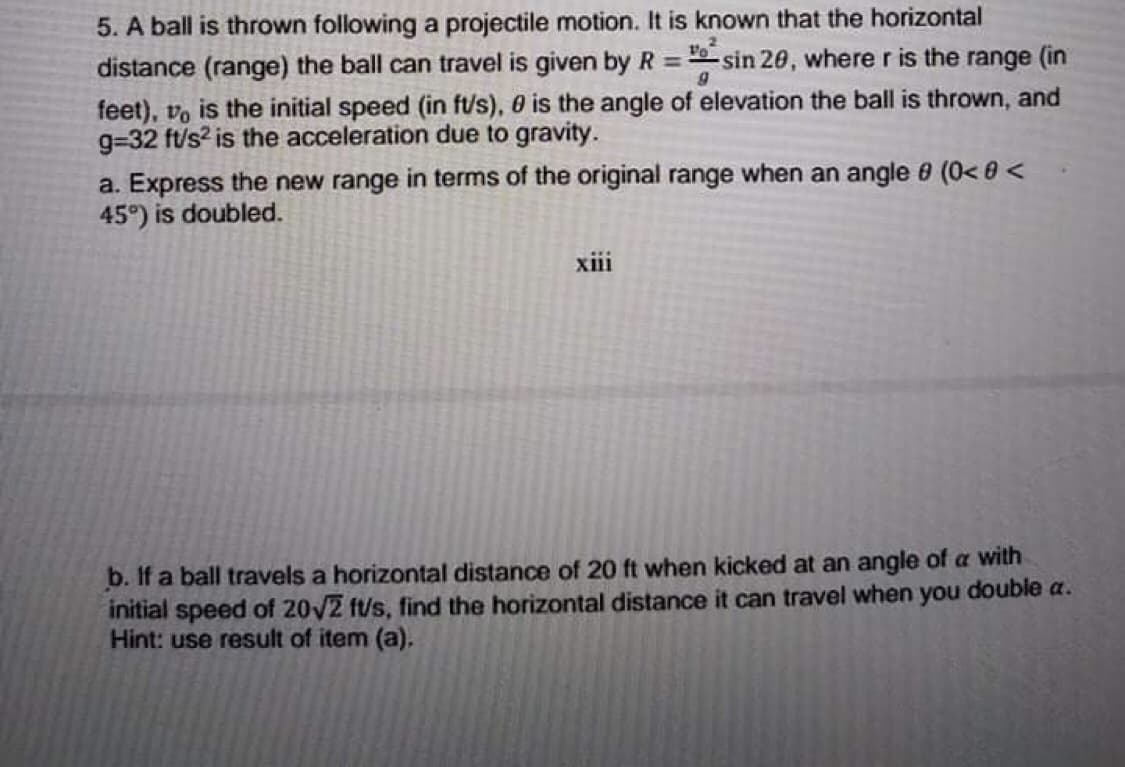5. A ball is thrown following a projectile motion. It is known that the horizontal distance (range) the ball can travel is given by R = sin 20, where r is the range (in feet), vo is the initial speed (in ft/s), 0 is the angle of elevation the ball is thrown, and g=32 ft/s2 is the acceleration due to gravity. a. Express the new range in terms of the original range when an angle 6 (0< 0 < 45°) is doubled. xiii b. If a ball travels a horizontal distance of 20 ft when kicked at an angle of a with initial speed of 20V2 ft/s, find the horizontal distance it can travel when you double a. Hint: use result of item (a).
5. A ball is thrown following a projectile motion. It is known that the horizontal distance (range) the ball can travel is given by R = sin 20, where r is the range (in feet), vo is the initial speed (in ft/s), 0 is the angle of elevation the ball is thrown, and g=32 ft/s2 is the acceleration due to gravity. a. Express the new range in terms of the original range when an angle 6 (0< 0 < 45°) is doubled. xiii b. If a ball travels a horizontal distance of 20 ft when kicked at an angle of a with initial speed of 20V2 ft/s, find the horizontal distance it can travel when you double a. Hint: use result of item (a).
College Physics
1st Edition
ISBN:9781938168000
Author:Paul Peter Urone, Roger Hinrichs
Publisher:Paul Peter Urone, Roger Hinrichs
Chapter3: Two-dimensional Kinematics
Section: Chapter Questions
Problem 46PE: A basketball player is running at 5.00 m/s directly toward the basket when he jumps into the air to...
Related questions
Question

Transcribed Image Text:5. A ball is thrown following a projectile motion. It is known that the horizontal
distance (range) the ball can travel is given by R = sin 20, where r is the range (in
%3D
feet), vo is the initial speed (in f/s), 0 is the angle of elevation the ball is thrown, and
g=32 ft/s? is the acceleration due to gravity.
a. Express the new range in terms of the original range when an angle 8 (0< 0 <
45°) is doubled.
xiii
b. If a ball travels a horizontal distance of 20 ft when kicked at an angle of a with
initial speed of 20V2 ft/s, find the horizontal distance it can travel when you double a.
Hint: use result of item (a).
Expert Solution
This question has been solved!
Explore an expertly crafted, step-by-step solution for a thorough understanding of key concepts.
Step by step
Solved in 3 steps

Knowledge Booster
Learn more about
Need a deep-dive on the concept behind this application? Look no further. Learn more about this topic, physics and related others by exploring similar questions and additional content below.Recommended textbooks for you

College Physics
Physics
ISBN:
9781938168000
Author:
Paul Peter Urone, Roger Hinrichs
Publisher:
OpenStax College

College Physics
Physics
ISBN:
9781305952300
Author:
Raymond A. Serway, Chris Vuille
Publisher:
Cengage Learning

College Physics
Physics
ISBN:
9781285737027
Author:
Raymond A. Serway, Chris Vuille
Publisher:
Cengage Learning

College Physics
Physics
ISBN:
9781938168000
Author:
Paul Peter Urone, Roger Hinrichs
Publisher:
OpenStax College

College Physics
Physics
ISBN:
9781305952300
Author:
Raymond A. Serway, Chris Vuille
Publisher:
Cengage Learning

College Physics
Physics
ISBN:
9781285737027
Author:
Raymond A. Serway, Chris Vuille
Publisher:
Cengage Learning

University Physics Volume 1
Physics
ISBN:
9781938168277
Author:
William Moebs, Samuel J. Ling, Jeff Sanny
Publisher:
OpenStax - Rice University

Glencoe Physics: Principles and Problems, Student…
Physics
ISBN:
9780078807213
Author:
Paul W. Zitzewitz
Publisher:
Glencoe/McGraw-Hill

Physics for Scientists and Engineers with Modern …
Physics
ISBN:
9781337553292
Author:
Raymond A. Serway, John W. Jewett
Publisher:
Cengage Learning